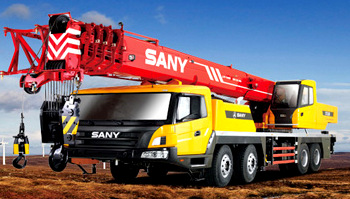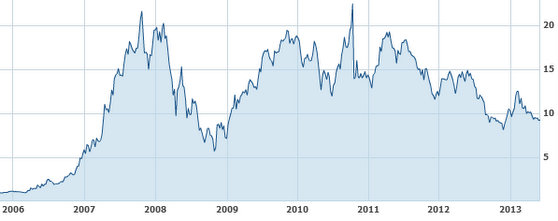Main reference: Story in Sinafinance
MR. WANG of Changsha, home to renowned Hunanese cuisine, turned 110,000 yuan into nearly 2.2 million yuan in few short years by primarily clinging to one stock.
What was it and how was he so successful putting all his eggs in one basket?
 Hunan's Mr. Wang made a small fortune buying shares early in Sany Heavy Industry, also from Hunan. Photo: SanyIt’s not often that market players are willing to share their secrets with potential competitors.
Hunan's Mr. Wang made a small fortune buying shares early in Sany Heavy Industry, also from Hunan. Photo: SanyIt’s not often that market players are willing to share their secrets with potential competitors.
But this retiree from Central China decided to spill the beans on his lucrative strategy as he has already cashed in his earnings and now hopes this one pick alone is enough to fund his golden years.
Wang’s bread and butter these past few years has been heavy machinery and earth-moving equipment manufacturer Sany Heavy Industry Co Ltd (SHA: 600031).
The 70,000-employee strong firm is also based in the lucky investor’s home province of Hunan and currently ranks as the sixth largest heavy equipment maker in the world.
Wang isn’t the only one to get rich with Sany.
The firm’s founder and top shareholder – Liang Wengen – was No.1 on Forbes’ list of China's richest people in 2011.
Wang got in on the ground floor with Sany, so to speak, buying in at around just under two yuan per share in late 2003, shortly after the firm launched its IPO.
 Investor Wang definitely got in on the ground floor with Sany's share price in 2003. The stock is now about half the value it achieved at its peak in 2010. Source: Yahoo FinanceWhen Wang decided to quit while he was ahead – way ahead – Sany shares were flirting with historical highs of 23 yuan and the savvy investor’s original capital had surged from 110,000 to nearly 2.2 million in 2011.
Investor Wang definitely got in on the ground floor with Sany's share price in 2003. The stock is now about half the value it achieved at its peak in 2010. Source: Yahoo FinanceWhen Wang decided to quit while he was ahead – way ahead – Sany shares were flirting with historical highs of 23 yuan and the savvy investor’s original capital had surged from 110,000 to nearly 2.2 million in 2011.
“I just kept hanging on. I knew that Rome wasn’t built in a day and neither could China be.
“But with the rapidly-growing economy at the time, I knew that strong support for infrastructure construction from Beijing all these years would pay off in spades for firms like Sany,” Wang said.
So other than being extremely lucky with his timing, what allowed him to make such a windfall profit with Sany – one of just several domestic industry peers building the machinery that builds China?
“I just adhered to a simple principle: ‘Keep holding, don’t sell’,” he explained.
He said he always had a strong identity with Sany as not only did he live near their headquarters and main factory, but the region was awash with advertisements promoting the idea that Sany would grow alongside China.
 In late 2011, Morgan Stanley bought 13 mln H shares of construction equipment firm Zoomlion -- a major rival of Sany. Photo: ZoomlionAnd this campaign took on a literal meaning for Wang as Hunan’s provincial capital of Changsha became a major second-tier city in its own right, with construction cranes stretching across the metro area for many years.
In late 2011, Morgan Stanley bought 13 mln H shares of construction equipment firm Zoomlion -- a major rival of Sany. Photo: ZoomlionAnd this campaign took on a literal meaning for Wang as Hunan’s provincial capital of Changsha became a major second-tier city in its own right, with construction cranes stretching across the metro area for many years.
He said knowing many employees, being very familiar with their products and business development strategy, and seeing first hand on a daily basis the company’s products on active display gave him a strong sense of common purpose and shared destiny with Sany.
Not only did he patiently hold onto his shares as they continued their gradual and then meteoric rise a couple years ago, but he also cashed in with generous dividends over the years.
“Dividend payouts were originally five yuan for every 10 shares held. This jumped to 10 shares gifted for each 10 held with an additional bonus dividend of two yuan the following year,” he said.
At this rate, it is easy to see how Wang’s original capital managed to multiply so quickly.
Sany eventually turned to rewarding shareholders with more shares come year-end.
This also led to a rapid rise in issued shares, with Sany’s original total of 240 million shares surging to nearly 5.1 billion at present – an over 21-fold increase in issued shares.
Wang was very fortunate to wager nearly his total expendable income at the time on a growth theme play like Sany that ended up delivering strong earnings, high dividends, and no serious external shocks to its order books.
But he would likely have done just as well if he put his money on another peer at the time – Zoomlion Heavy Industry (SZA: 000157).
Construction equipment maker Zoomlion listed in Shenzhen in 2000 at around 0.6 yuan per share, and is currently trading at around seven yuan per share.
Wang's success just goes to show us that sometimes it’s not so much the company you keep, but can be just as much about timing and picking the right sector.
See also:
My 22 Years Playing With A-Shares: A Speculator's Strategies







